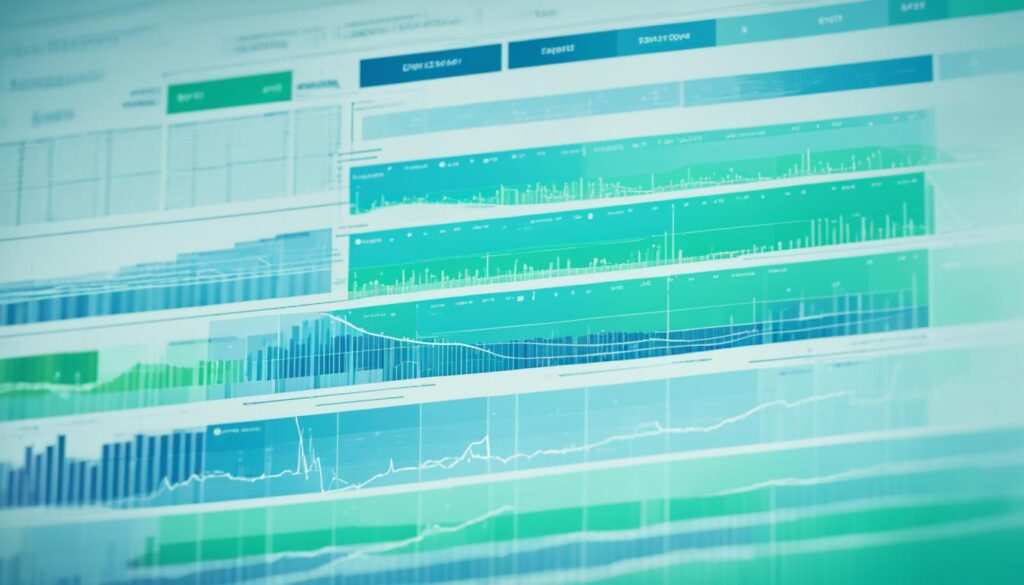The introduction of Big Data Analytics (BDA) in healthcare has the potential to revolutionize patient care and improve health outcomes. Big Data Analytics can provide advanced insights and analysis of large datasets, allowing healthcare providers to make data-driven decisions. Research has shown that the use of Big Data Analytics in medical facilities can bring numerous benefits, including improved healthcare management, better treatment outcomes, and the ability to identify at-risk individuals. Medical facilities in Poland have been adopting data-based healthcare approaches, using both structured and unstructured data from various sources such as databases, transaction data, and data from devices and sensors. The use of Big Data Analytics in healthcare is an ongoing trend that is expected to continue growing in the future.
Key Takeaways:
- Big Data Analytics in healthcare can revolutionize patient care and improve health outcomes.
- It provides advanced insights and analysis of large datasets, enabling data-driven decision making.
- Medical facilities in Poland are adopting data-based healthcare approaches.
- The use of Big Data Analytics in healthcare is an ongoing trend that will continue to grow.
- Improved healthcare management, better treatment outcomes, and identification of at-risk individuals are among the benefits of Big Data Analytics in healthcare.
The Benefits of Data Analytics in Healthcare
Data analytics in healthcare offers several key benefits. It allows healthcare providers to identify at-risk individuals and provide them with targeted care, resulting in improved patient outcomes and reduced costs. By analyzing large datasets, healthcare organizations can gain valuable insights into patient diagnosis and treatment methods, leading to more effective and personalized healthcare. Data analytics also plays a crucial role in uncovering and combatting health disparities by identifying clusters of diseases and disorders among certain communities and groups. Additionally, data analytics can help identify environmental factors that influence disease progression, enabling better prevention strategies. Overall, data analytics in healthcare is essential for improving patient care, optimizing healthcare processes, and driving data-driven decision making.
Improved Patient Outcomes
Data analytics in healthcare enables healthcare providers to identify at-risk individuals and provide them with targeted care. By analyzing patient data, such as medical history, genetic information, lifestyle factors, and social determinants of health, healthcare professionals can better understand patient needs and develop personalized treatment plans. This leads to improved patient outcomes, as healthcare interventions can be tailored to address individual needs and conditions.
Cost Reduction
Healthcare analytics solutions can help identify areas of inefficiency and waste in healthcare processes, leading to cost reduction. By analyzing data on resource utilization, billing and payment patterns, and healthcare outcomes, organizations can optimize resource allocation, streamline operations, and reduce unnecessary expenditures. This not only improves financial sustainability but also ensures that resources are used effectively to provide quality care to patients.
Health Disparities Identification and Intervention
Health disparities refer to differences in health outcomes between different populations or groups. Data analytics plays a crucial role in identifying clusters of diseases and disorders among certain communities, helping to uncover underlying causes and develop targeted interventions. By analyzing demographic data, socioeconomic factors, and health indicators, healthcare organizations can address disparities in access to care, health outcomes, and treatment effectiveness.
Environmental Factors and Disease Prevention
Data analytics can help identify environmental factors that impact disease progression and spread. By analyzing data on air quality, water contamination, geographic location, and population density, healthcare providers can develop prevention strategies and interventions to mitigate the impact of environmental factors on public health. This proactive approach to disease prevention can lead to improved population health and reduced healthcare costs in the long run.
| Benefits of Data Analytics in Healthcare |
|---|
| Improved Patient Outcomes |
| Cost Reduction |
| Health Disparities Identification and Intervention |
| Environmental Factors and Disease Prevention |
The Role of Data Analytics in Health Administration
Data analytics is not only beneficial for healthcare providers but also for health administrators. By utilizing data analytics, health administrators can gain valuable insights into operational practices, patient satisfaction rates, and financial data to improve overall healthcare performance.
“Data analytics provides health administrators with the tools to analyze large datasets and identify trends and patterns that can inform decision-making and drive improvements in healthcare delivery.”
With data analytics tools, administrators can analyze administrative and financial data, as well as healthcare staff scheduling trends, enabling them to make informed decisions and lower healthcare costs. By identifying key performance indicators and tracking healthcare data insights, administrators can optimize resource allocation, streamline operational processes, and enhance overall healthcare performance.
“Data analytics in health administration can uncover opportunities for operational improvements and facilitate effective resource allocation to meet the growing demand for quality healthcare.”
The use of data analytics in healthcare administration is becoming increasingly important, especially with the need to address various challenges in the healthcare industry. By harnessing the power of healthcare performance analysis, health administrators can make data-driven decisions that positively impact patient care, staff productivity, and financial sustainability.
Improved Decision-Making through Data Analytics
Data analytics in health administration empowers administrators to make informed decisions by providing insights into healthcare key performance indicators and trends. By leveraging the power of data, administrators can:
- Identify areas for improvement in healthcare processes
- Optimize resource allocation based on patient demand
- Monitor financial performance and identify opportunities for cost savings
- Improve patient satisfaction rates through targeted interventions
By using healthcare data insights, administrators can implement evidence-based strategies that drive operational efficiency and improve patient outcomes.
A Case in Point: Healthcare Performance Analysis
Let’s take a look at a real-world example of how data analytics can benefit health administration. In a large hospital system, healthcare performance analysis revealed that emergency department wait times were significantly impacting patient satisfaction scores. By analyzing historical data and current patient flow, administrators identified bottlenecks in the triage process.

| Key Findings | Action Taken |
|---|---|
| Long wait times during peak hours | Implemented additional triage nurses during peak periods |
| Inefficient triage process | Streamlined triage process with a digital tool |
| Inaccurate patient flow predictions | Implemented predictive analytics to forecast patient volumes |
By addressing these issues and making data-driven changes, the hospital system was able to reduce emergency department wait times by 40% and improve patient satisfaction scores by 25%. This example showcases the power of healthcare performance analysis in driving meaningful improvements in healthcare administration.
“Data analytics is a game-changer in health administration, providing valuable insights that drive operational excellence and ultimately enhance the quality of patient care.”
The Future of Data Analytics in Healthcare
The future of data analytics in healthcare is promising. As technology advances and data collection methods improve, the potential for predictive analytics in healthcare grows. Predictive analytics can help healthcare organizations forecast trends, predict disease outbreaks, and make informed decisions to optimize patient care. Additionally, healthcare data visualization is expected to play a significant role in presenting complex healthcare data in a user-friendly and easily understandable format.
With the increasing availability of healthcare data, the demand for data analytics professionals in the healthcare industry is also expected to rise. Data analytics will continue to evolve and shape the future of healthcare, leading to more personalized and data-driven approaches to patient care.

“Predictive analytics can help healthcare organizations forecast trends, predict disease outbreaks, and make informed decisions to optimize patient care.”
The Role of Predictive Analytics
Predictive analytics leverages historical data, statistical algorithms, and machine learning techniques to generate insights and make predictions about future events. In healthcare, this can be invaluable for identifying patients at risk of developing certain conditions or needing specific treatments. By analyzing patterns and trends, healthcare providers can intervene earlier, prevent complications, and enhance patient outcomes.
Predictive analytics can also assist healthcare organizations in optimizing resource allocation and improving operational efficiency. By forecasting patient volume and demand for specific services, healthcare providers can allocate staff, equipment, and supplies more effectively, reducing wait times and enhancing overall patient satisfaction.
Healthcare Data Visualization
As healthcare generates a vast amount of complex data, effective data visualization becomes crucial for understanding and communicating insights. Healthcare data visualization uses visual elements like charts, graphs, and infographics to represent healthcare data in a more accessible and meaningful way.
This visual representation allows healthcare professionals, administrators, and patients to grasp key trends, patterns, and relationships that may not be apparent when dealing with raw data alone. By presenting data visually, healthcare stakeholders can make informed decisions, detect anomalies, and identify areas for improvement more easily.
“Data analytics will continue to evolve and shape the future of healthcare, leading to more personalized and data-driven approaches to patient care.”
| Benefits of Predictive Analytics in Healthcare | Role of Healthcare Data Visualization |
|---|---|
|
|
Conclusion
Data analytics in healthcare has revolutionized the way healthcare providers operate, improving patient outcomes and optimizing healthcare processes. By harnessing the power of healthcare data insights, providers have been able to make data-driven decisions to enhance healthcare delivery, resulting in better health results for patients.
Through healthcare performance analysis, data analytics enables healthcare providers to identify at-risk individuals and tailor their care to meet specific needs. This personalized approach not only improves patient outcomes but also helps in reducing costs.
Furthermore, data analytics plays a vital role in health administration by empowering administrators to make data-driven decisions that enhance overall healthcare performance and drive down costs. By analyzing operational practices, patient satisfaction rates, and financial data, administrators can identify areas for improvement and allocate resources effectively.
The future of data analytics in healthcare is incredibly promising. Advancements in technology and the increasing availability of healthcare data will only further enhance the potential of data analytics in transforming the healthcare industry. Predictive analytics in healthcare and innovative data visualization techniques will drive even more personalized and data-driven approaches to patient care.
As the healthcare industry continues to evolve, data analytics will remain a critical tool in driving better health outcomes and revolutionizing healthcare delivery. Leveraging the power of healthcare data insights and healthcare performance analysis, providers and administrators can continue to improve patient care, enhance operational efficiency, and shape the future of healthcare.
FAQ
What is data analytics in healthcare?
Data analytics in healthcare involves the use of advanced technologies and techniques to analyze large datasets and gain valuable insights that can improve patient care, optimize healthcare processes, and drive data-driven decision making.
What are the benefits of data analytics in healthcare?
Data analytics in healthcare offers several key benefits, including improved patient outcomes, reduced costs, personalized healthcare, identification of at-risk individuals, combatting health disparities, and better prevention strategies.
How does data analytics benefit health administrators?
Data analytics provides valuable insights for health administrators, enabling them to make informed decisions regarding operational practices, patient satisfaction rates, financial data, staff scheduling, and resource allocation to improve overall healthcare performance and lower costs.
What is the future of data analytics in healthcare?
The future of data analytics in healthcare is promising, with the potential for predictive analytics to forecast trends, predict disease outbreaks, and optimize patient care. Healthcare data visualization is also expected to play a significant role in presenting complex healthcare data in a user-friendly format.
How does data analytics contribute to better health outcomes?
By leveraging the power of data analytics, healthcare providers can identify at-risk individuals, improve diagnostic and treatment methods, combat health disparities, and understand the impact of environmental factors on disease progression, leading to better health outcomes and more personalized approaches to patient care.








